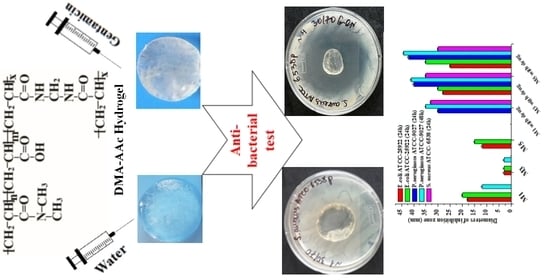Synthesis, Characterization and Antibacterial Application of Copolymers Based on N,N-Dimethyl Acrylamide and Acrylic Acid
Abstract
:1. Introduction
2. Materials and Methods
2.1. Materials
2.2. Synthesis of Copolymers
2.3. Instrumentation and Methods
2.4. Monomer Reactivity Ratio
2.5. Antibacterial Tests
3. Results and Discussion
3.1. FTIR Analysis of Poly(DMA-co-AAc) Hydrogel
3.2. Monomer Reactivity Ratio
3.3. Thermogravimetric Analyses (TGA)
3.4. Scanning Electron Microscopy (SEM)
3.5. Antibacterial Abilities of the Hydrogels Immobilized with the Drugs
4. Conclusions
Author Contributions
Funding
Institutional Review Board Statement
Informed Consent Statement
Data Availability Statement
Acknowledgments
Conflicts of Interest
References
- Osada, Y.; Ross-Murphy, S.B. Intelligent gels. Sci. Am. 1993, 5, 82–87. [Google Scholar] [CrossRef]
- Hoffman, A.S. Hydrogels for biomedical applications. Adv. Drug Deliv. Rev. 2002, 54, 3–12. [Google Scholar] [CrossRef]
- Qu, J.; Zhao, X.; Ma, P.X.; Guo, B. Injectable antibacterial conductive hydrogels with dual response to an electric field and pH for localized “smart” drug release. Acta Biomater. 2018, 72, 55–69. [Google Scholar] [CrossRef]
- Mullarney, M.P.; Seery, T.; Weiss, R. Drug diffusion in hydrophobically modified N,N-dimethylacrylamide hydrogels. Polymer 2006, 47, 3845–3855. [Google Scholar] [CrossRef]
- Mao, J.; Yu, Q.J.; Wang, S. Preparation of multifunctional hydrogels with pore channels using agarose sacrificial templates and its applications. Polym. Adv. Technol. 2021, 32, 1752–1762. [Google Scholar] [CrossRef]
- Algi, M.P.; Okay, O. Highly stretchable self-healing poly(N,N-dimethylacrylamide) hydrogels. Eur. Polym. J. 2014, 59, 113–121. [Google Scholar] [CrossRef]
- Hernandez-Martíneza, A.R.; Lujan-Montelongo, J.A. Swelling and methylene blue adsorption of poly(N,N-dimethylacrylamide-co-2-hydroxyethyl methacrylate) hydrogel. React. Funct. Polym. 2018, 122, 75–84. [Google Scholar] [CrossRef]
- Yin, X.; Stover, H.D.H. Temperature-sensitive hydrogel microspheres formed by liquid–liquid phase transitions of aqueous solutions of Poly(N,N-dimethylacrylamide-co-allyl methacrylate). J. Polym. Sci. Part A Polym. Chem. 2005, 43, 1641–1648. [Google Scholar] [CrossRef]
- Cheng, F.; Yi, J.; Ya, Z.; Zhong, L. Effect of N,N-dimethylacrylamide (DMA) on the comprehensive properties of acrylic latex pressure sensitive adhesives. Int. J. Adhes. Adhes. 2016, 71, 105–111. [Google Scholar] [CrossRef]
- Polic, A.L.; Duever, T.A.; Penlidis, A. Case studies and literature review on the estimation of copolymerization reactivity ratios. J. Polym. Sci. Part A Polym. Chem. 1998, 36, 813–822. [Google Scholar] [CrossRef]
- Biryan, F.; Demirelli, K. Copolymerization of benzyl methacrylate and a methacrylate bearing benzophenoxy and hydroxyl side groups: Monomer reactivity ratios, thermal studies and dielectric measurements. Fibers Polym. 2017, 18, 1629–1637. [Google Scholar] [CrossRef]
- Rusu, L.-C.; Ardelean, L.C.; Jitariu, A.-A.; Miu, C.A.; Streian, C.G. An Insight into the Structural Diversity and Clinical Applicability of Polyurethanes in Biomedicine. Polymers 2020, 12, 1197. [Google Scholar] [CrossRef] [PubMed]
- Takeuchi, M.T.; Kojima, M.; Luetzow, M. State of the art on the initiatives and activities relevant to risk assessment and risk management of nanotechnologies in the food and agriculture sectors. Food Res. Int. 2014, 64, 976–981. [Google Scholar] [CrossRef]
- Nakan, U.; Rahmetullaeva, K.R.; Mun, G.A.; Shaihutdinov, E.M.; El-Sayed, N. Linear Copolymer of N-Isopropylacrylamide and 2-Hydroxyethylacrylate: Synthesis, Characterization and Monomer Reactivity Ratios. Orient. J. Chem. 2016, 32, 2347–2354. [Google Scholar] [CrossRef]
- Nakan, U.; Mun, G.A.; Shaikhutdinov, E.M.; Bieerkehazhi, S.; El-Sayed, N. Hydrogels based on N-isopropylacrylamide and 2-hydroxyethylacrylate: Synthesis, characterization and investigation of their antibacterial activity. Polym. Int. 2020, 69, 1220–1226. [Google Scholar] [CrossRef]
- Nakan, U.; Mun, G.A. Thermosensitive N-isopropylacrylamide -co-2-hydroxyethyl acrylate hydrogels interactions with Poly(acrylic acid) and surfactants. Polym. Adv. Technol. 2021, 32, 2676–2681. [Google Scholar] [CrossRef]
- Nakan, U.; Rahmetullayeva, R.K.; Mun, G.A. Synthesis of water soluble copolymers and their interpolymer complexes with Poly(acrylic acid). J. Chem. Technol. Metall. 2018, 53, 183–187. [Google Scholar]
- Abdollahi, H.; Najafi, V.; Amiri, F. Determination of monomer reactivity ratios and thermal properties of poly(GMA-co-MMA) copolymers. Polym. Bull. 2021, 78, 493–511. [Google Scholar] [CrossRef]
- Fineman, M.; Ross, S.D. Linear method for determining monomer reactivity ratios in copolymerization. J. Polym. Sci. 1950, 5, 259–265. [Google Scholar] [CrossRef]
- Kelen, T.; Tüdös, F. Analysis of the linear methods for determining the copolymerization reactivity ratios I. A new improved linear graphic method. J. Macromol. Sci. Part A Pure Appl. Chem. 1975, 9, 1–27. [Google Scholar] [CrossRef]
- Mayo, F.R.; Lewis, F.M. Copolymerization. I. A Basis for Comparing the Behavior of Monomers in Copolymerization; The Copolymerization of Styrene and Methyl Methacrylate. J. Am. Chem. Soc. 1944, 66, 1594–1601. [Google Scholar] [CrossRef]
- Bhattacharyya, R.; Ray, S.K. Enhanced adsorption of synthetic dyes from aqueous solution by a semi-interpenetrating network hydrogel based on starch. J. Ind. Eng. Chem. 2014, 20, 3714–3725. [Google Scholar] [CrossRef]
- Hai, A.F.; Wahab, H.A.; Ibrahim, A. Synthesis, characterization and thermal properties of thiazole containing polymers. Malays Polym. J. 2014, 9, 1–9. [Google Scholar]
- Sadeghi, M.; Hanifpour, F.; Taheri, R.; Javadian, H.; Ghasemi, M. Comparison of us-ing formaldehyde and carboxy methyl chitosan in preparation of Fe3O4 superpara-magnetic nanoparticles-chitosan hydrogel network: Sorption behavior toward bo-vine serum albumin. Process Saf. Environ. 2016, 102, 119–128. [Google Scholar] [CrossRef]
- Moharram, M.A.; Khafagi, M.G. Thermal behavior of Poly(acrylic acid)–Poly(vinylpyrrolidone) and Poly(acrylic acid)–metal–Poly(vinylpyrrolidone) complexes. J. Appl. Polym. Sci. 2006, 102, 4049–4057. [Google Scholar] [CrossRef]
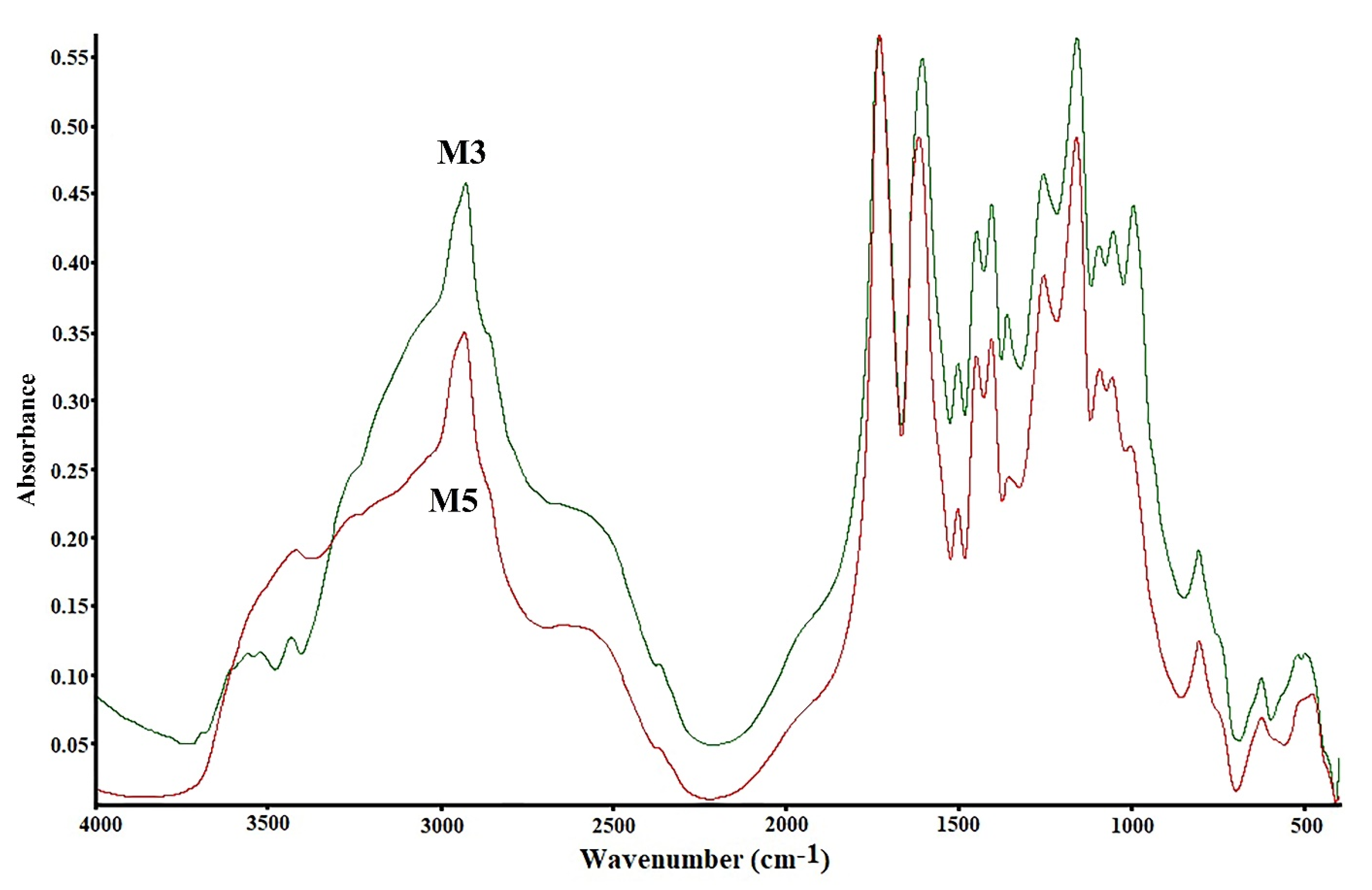
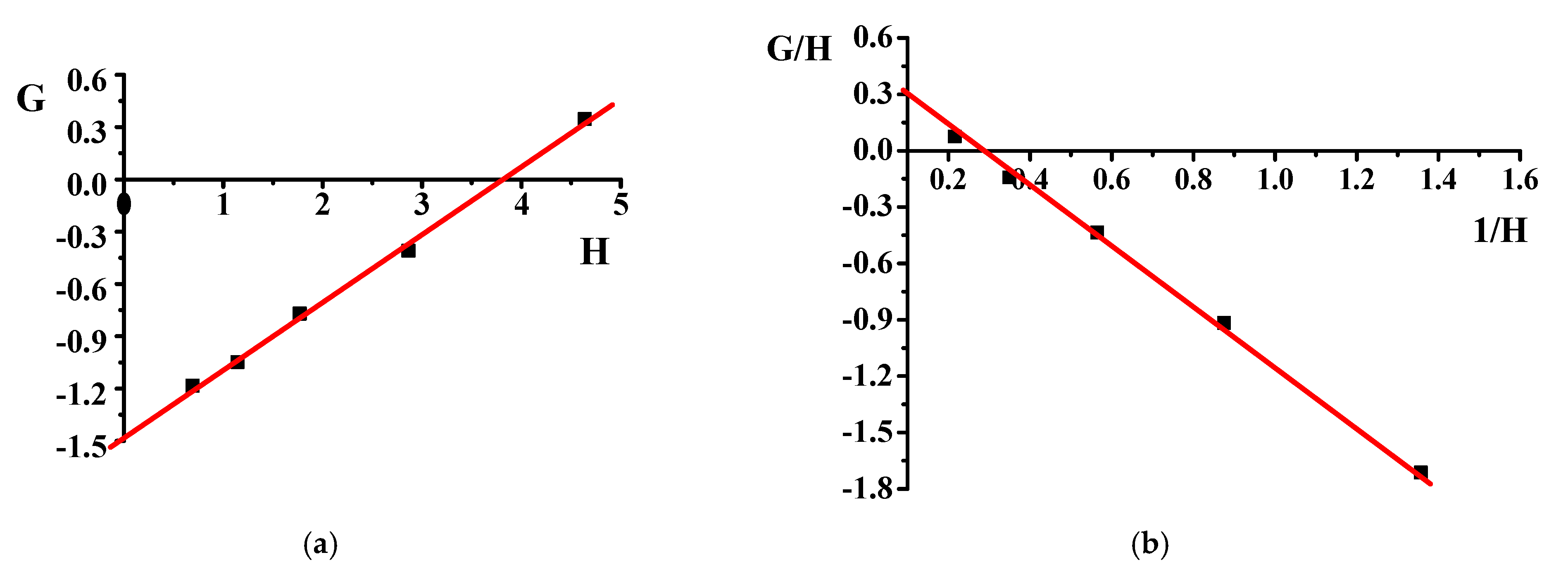
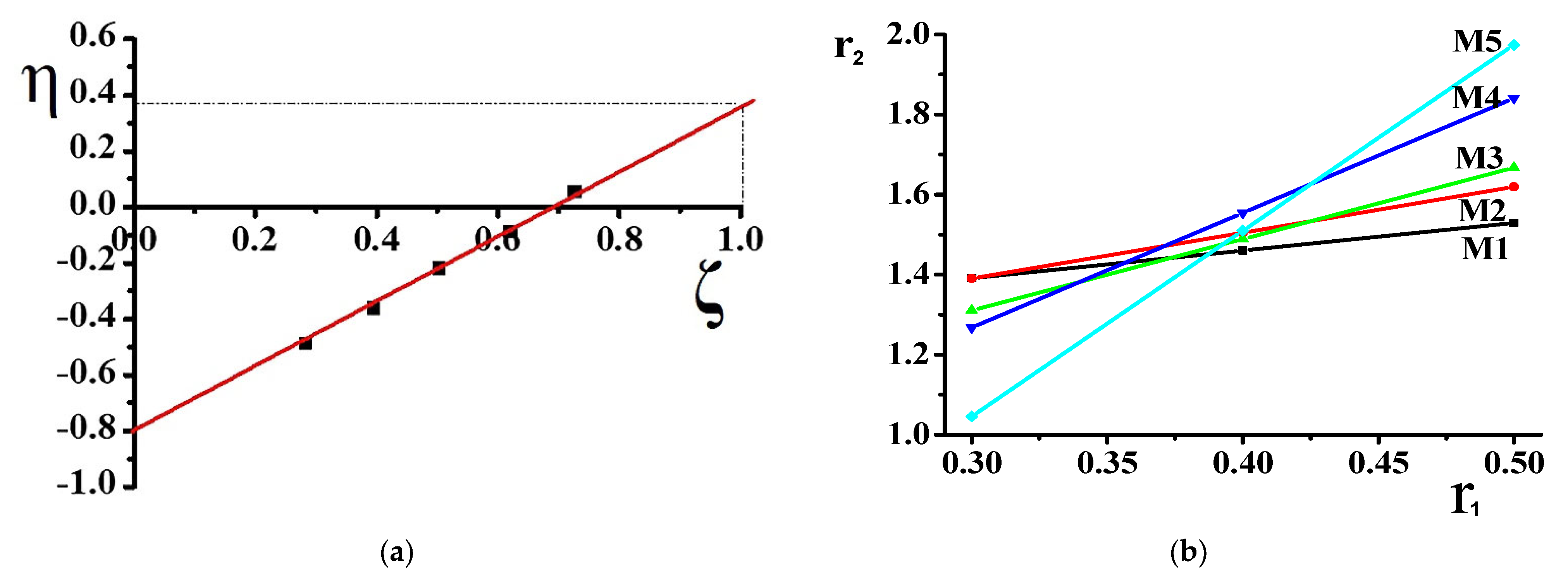
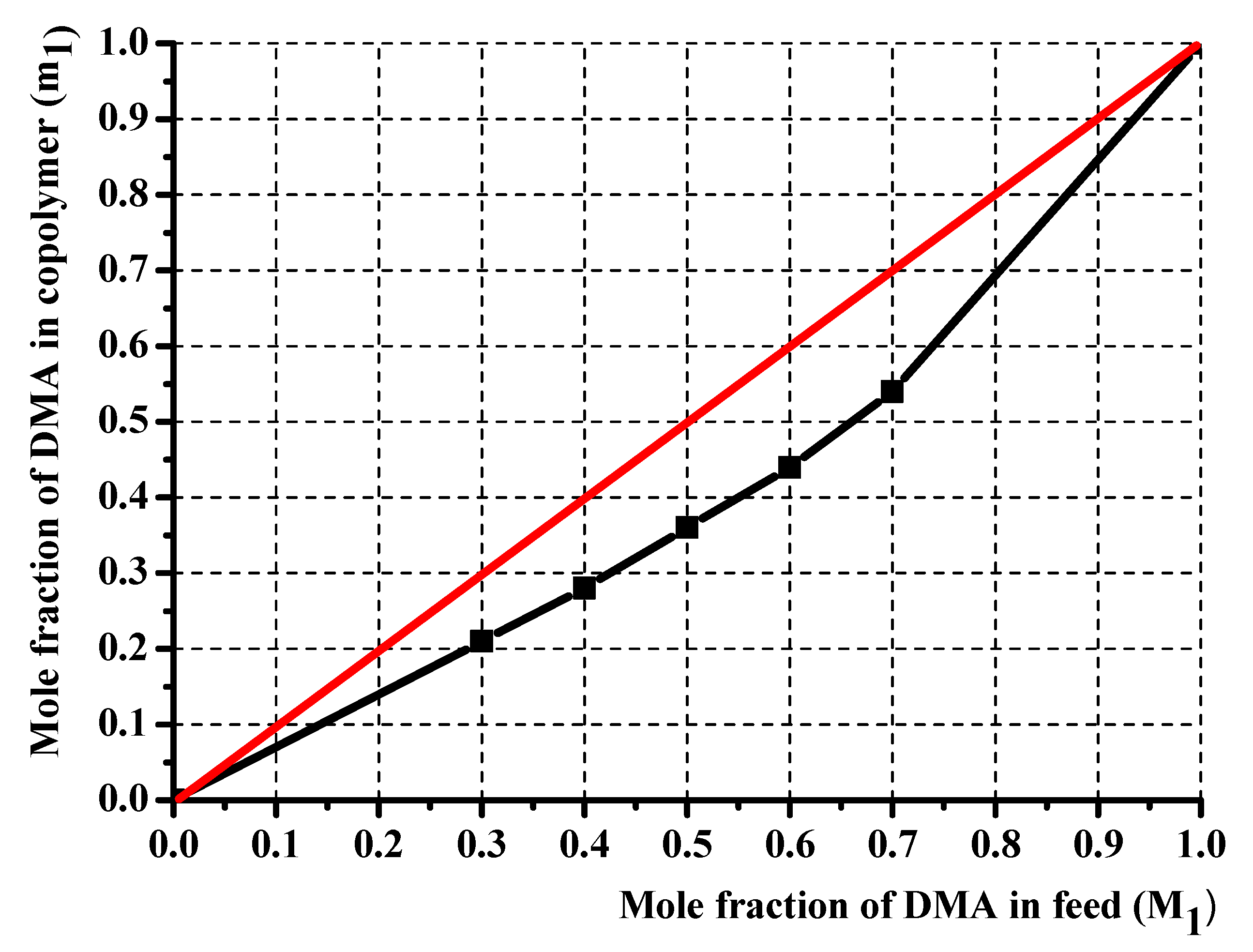
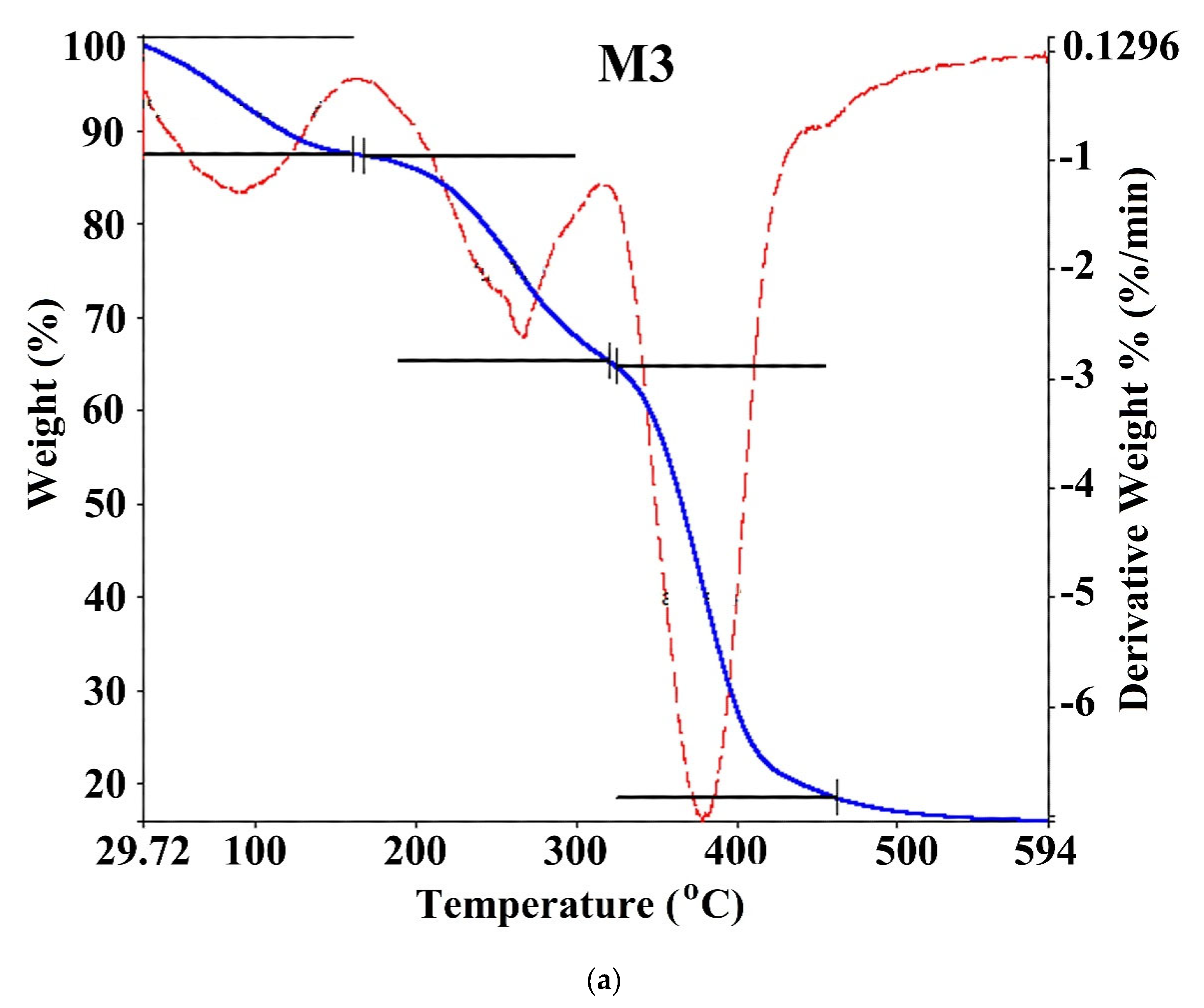
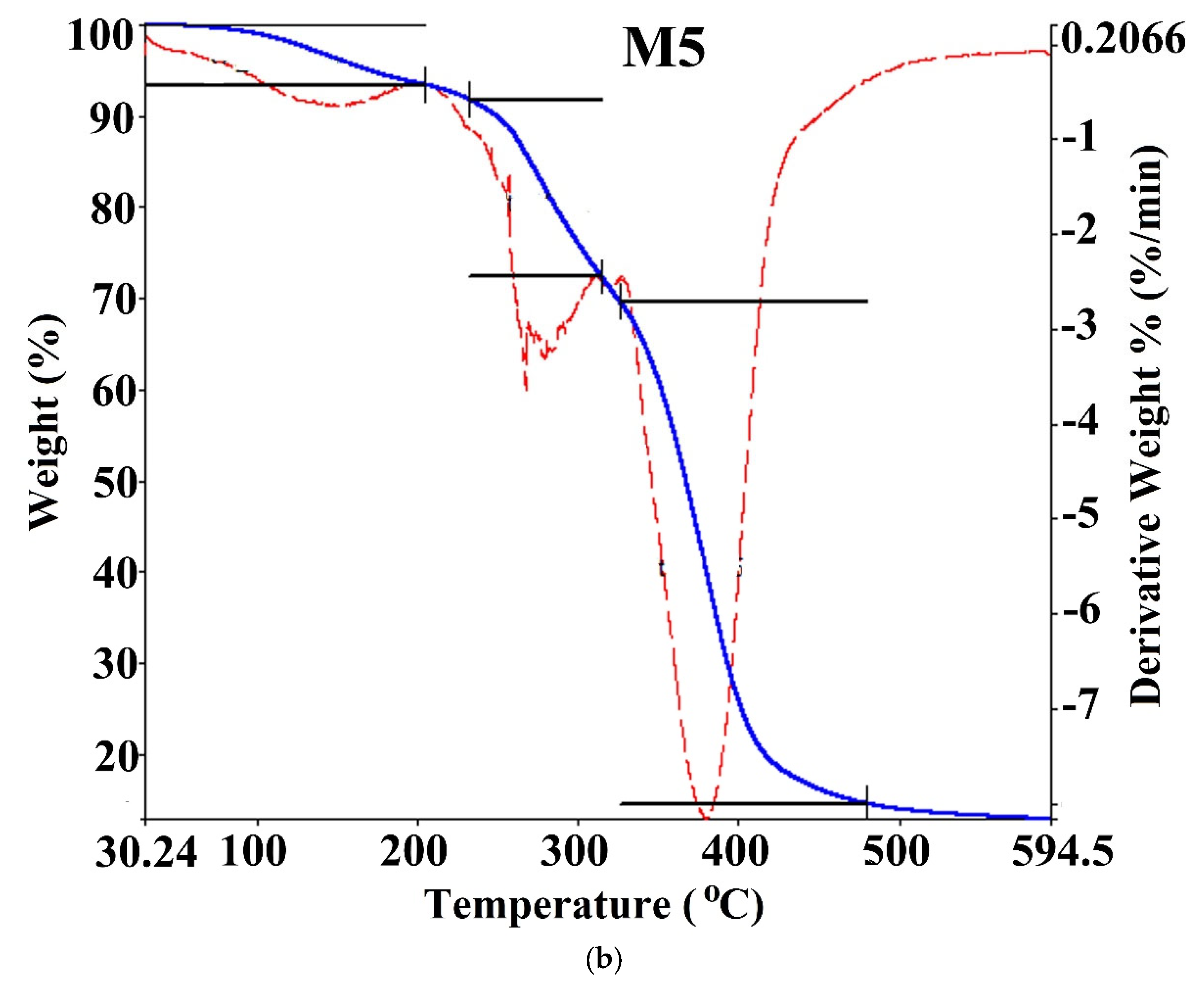
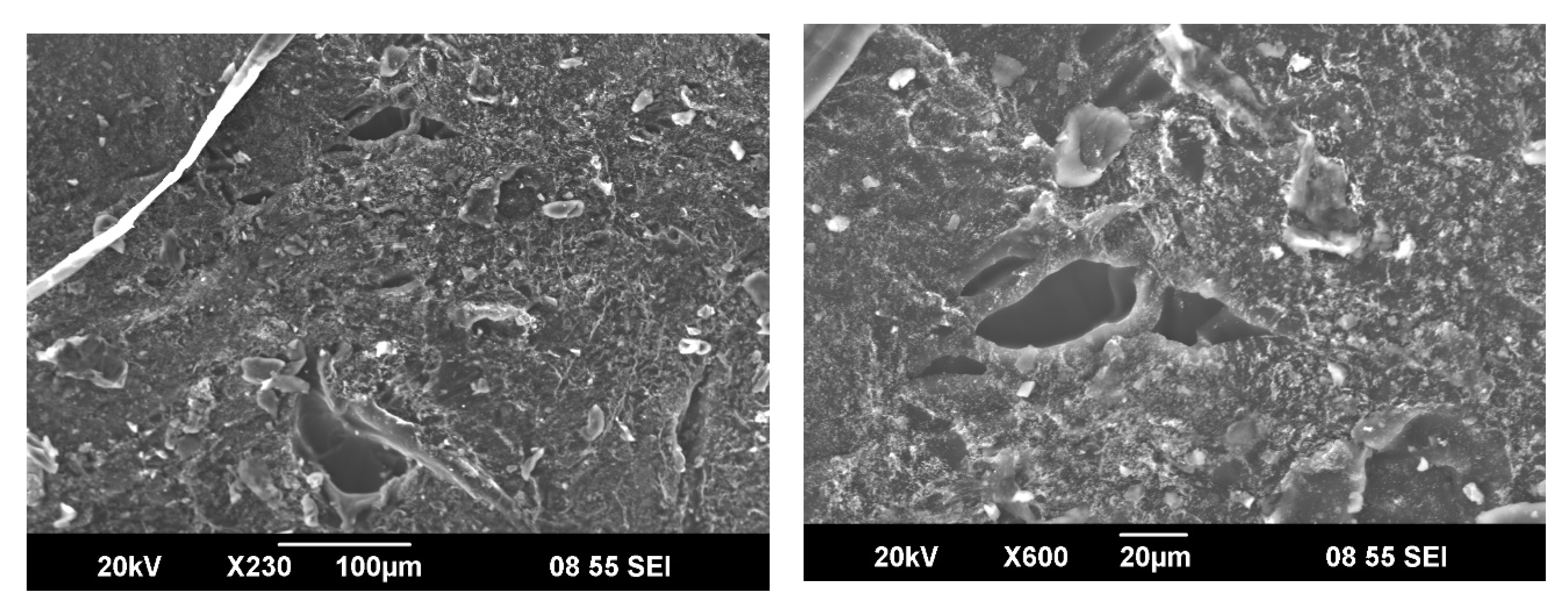
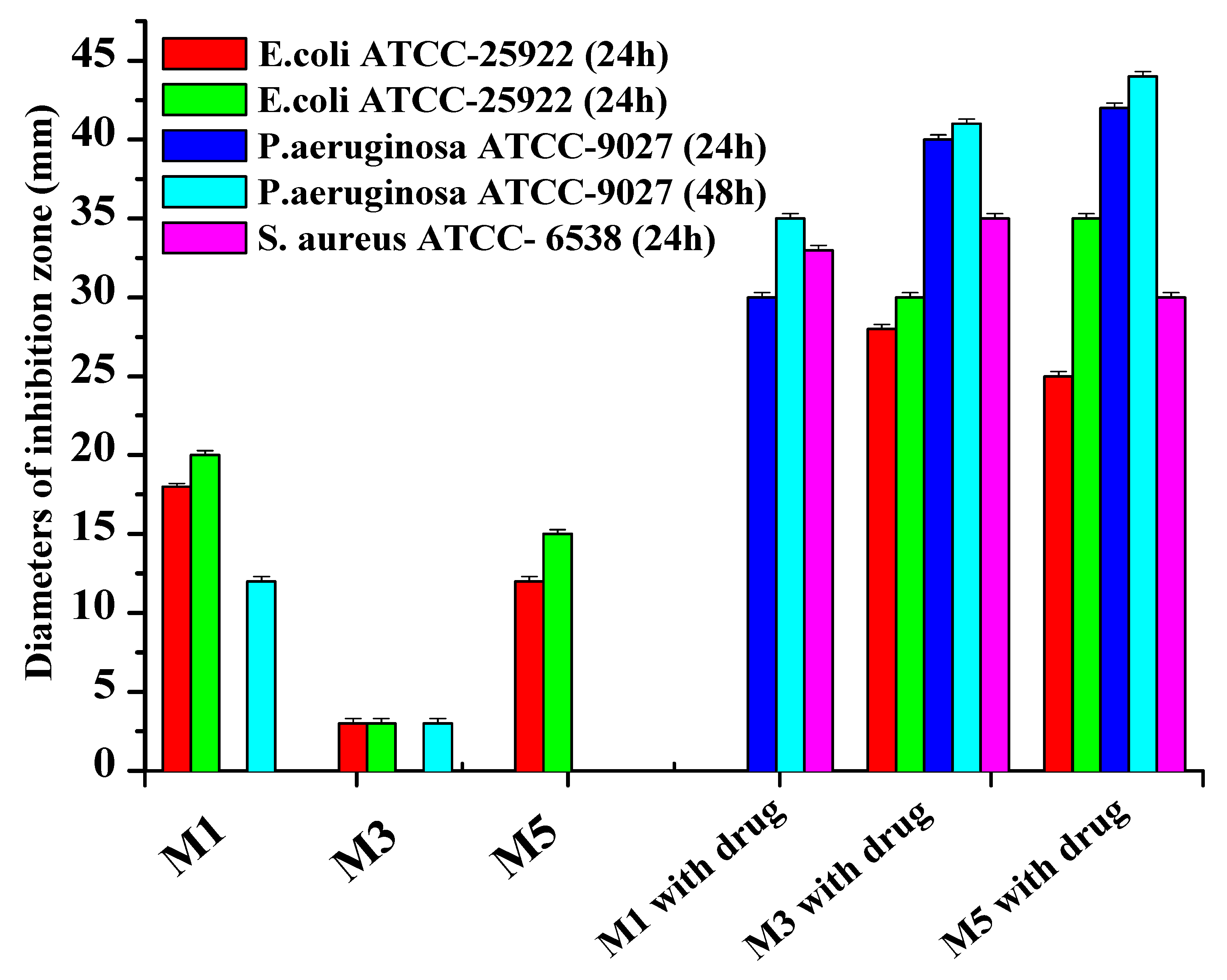

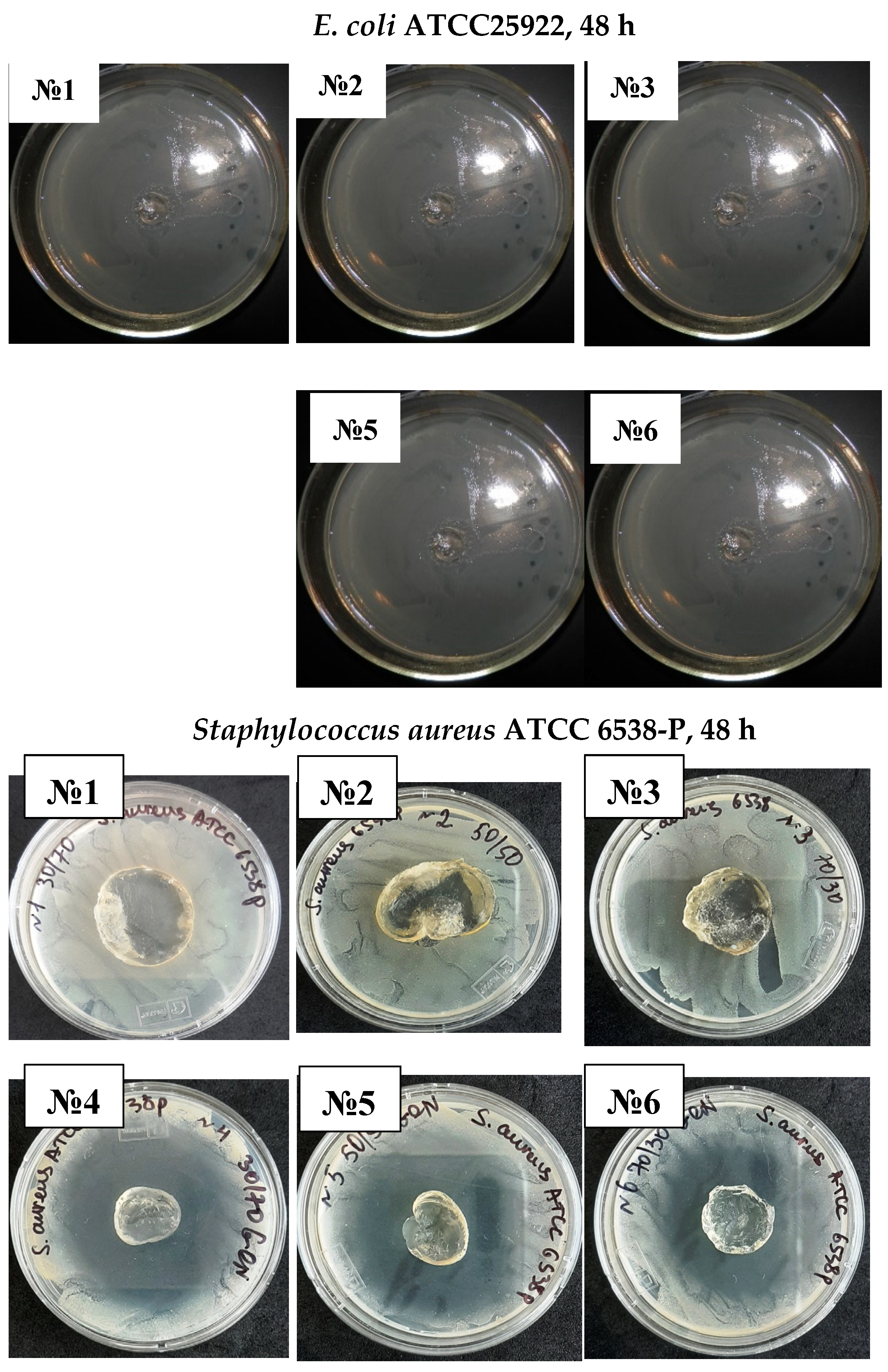
| № Copolymer | Mole Fraction of DMA in Feed, (M1) | Elemental Analysis N, % | Mole Fraction of DMA in Copolymers, (m1) * | Fineman–Ross | Kelen–Tudos | Inverted Fineman–Ross | |||||
|---|---|---|---|---|---|---|---|---|---|---|---|
| F = M1/M2 | f = m1/m2 | G = F(f−1)/f | H = F2/f | η = G/(α + H) | ζ = H/(α + H) | G/H | 1/H | ||||
| M1 | 30 | 3.85 | 21 | 0.4286 | 0.2658 | −1.1839 | 0.6911 | −0.4885 | 0.2831 | −1.7131 | 1.4469 |
| M2 | 40 | 4.93 | 28 | 0.6667 | 0.3889 | −1.0476 | 1.1429 | −0.3621 | 0.3945 | −0.9166 | 0.8749 |
| M3 | 50 | 6.167 | 36 | 1 | 0.5625 | −0.778 | 1.778 | −0.2189 | 0.5029 | −0.4353 | 0.5647 |
| M4 | 60 | 7.37 | 44 | 1.5 | 0.7857 | −0.4091 | 2.8636 | −0.089 | 0.6210 | −0.1429 | 0.3492 |
| M5 | 70 | 8.71 | 54 | 2.3333 | 1.1739 | 0.3457 | 4.6378 | 0.0541 | 0.7261 | 0.0745 | 0.2156 |
| № | Methods | r1 | r2 | r1*r2 |
|---|---|---|---|---|
| 1 | Fineman–Ross (FR) | 0.38 | 1.45 | 0.55 |
| 2 | Inverted Fineman–Ross (IFR) | 0.38 | 1.46 | 0.55 |
| 3 | Kelen–Tudos (KT) | 0.38 | 1.43 | 0.54 |
| 4 | Mayo–Lewis | 0.38 | 1.45 | 0.57 |
| Copolymer | Temperature Decomposition (°C) | Weight Loss (%) | Residual (%) | PDTmax (°C) |
|---|---|---|---|---|
| M3 | 29.72–160.31 | 12.576 | 87.624 | 380.92 |
| 160.31–322 | 22.424 | 65 | ||
| 322–594 | 49 | 16 | ||
| M5 | 30.24–209.6 | 6.76 | 93.24 | 378.12 |
| 209.6–317.36 | 21.61 | 71.63 | ||
| 317.36–594.5 | 58.71 | 12.92 |
Publisher’s Note: MDPI stays neutral with regard to jurisdictional claims in published maps and institutional affiliations. |
© 2021 by the authors. Licensee MDPI, Basel, Switzerland. This article is an open access article distributed under the terms and conditions of the Creative Commons Attribution (CC BY) license (https://creativecommons.org/licenses/by/4.0/).
Share and Cite
Nakan, U.; Bieerkehazhi, S.; Tolkyn, B.; Mun, G.A.; Assanov, M.; Nursultanov, M.E.; Rakhmetullayeva, R.K.; Toshtay, K.; Negim, E.-S.; Ydyrys, A. Synthesis, Characterization and Antibacterial Application of Copolymers Based on N,N-Dimethyl Acrylamide and Acrylic Acid. Materials 2021, 14, 6191. https://doi.org/10.3390/ma14206191
Nakan U, Bieerkehazhi S, Tolkyn B, Mun GA, Assanov M, Nursultanov ME, Rakhmetullayeva RK, Toshtay K, Negim E-S, Ydyrys A. Synthesis, Characterization and Antibacterial Application of Copolymers Based on N,N-Dimethyl Acrylamide and Acrylic Acid. Materials. 2021; 14(20):6191. https://doi.org/10.3390/ma14206191
Chicago/Turabian StyleNakan, Ulantay, Shayahati Bieerkehazhi, Balgyn Tolkyn, Grigoriy A. Mun, Mukhit Assanov, Merey E. Nursultanov, Raikhan K. Rakhmetullayeva, Kainaubek Toshtay, El-Sayed Negim, and Alibek Ydyrys. 2021. "Synthesis, Characterization and Antibacterial Application of Copolymers Based on N,N-Dimethyl Acrylamide and Acrylic Acid" Materials 14, no. 20: 6191. https://doi.org/10.3390/ma14206191
APA StyleNakan, U., Bieerkehazhi, S., Tolkyn, B., Mun, G. A., Assanov, M., Nursultanov, M. E., Rakhmetullayeva, R. K., Toshtay, K., Negim, E.-S., & Ydyrys, A. (2021). Synthesis, Characterization and Antibacterial Application of Copolymers Based on N,N-Dimethyl Acrylamide and Acrylic Acid. Materials, 14(20), 6191. https://doi.org/10.3390/ma14206191






